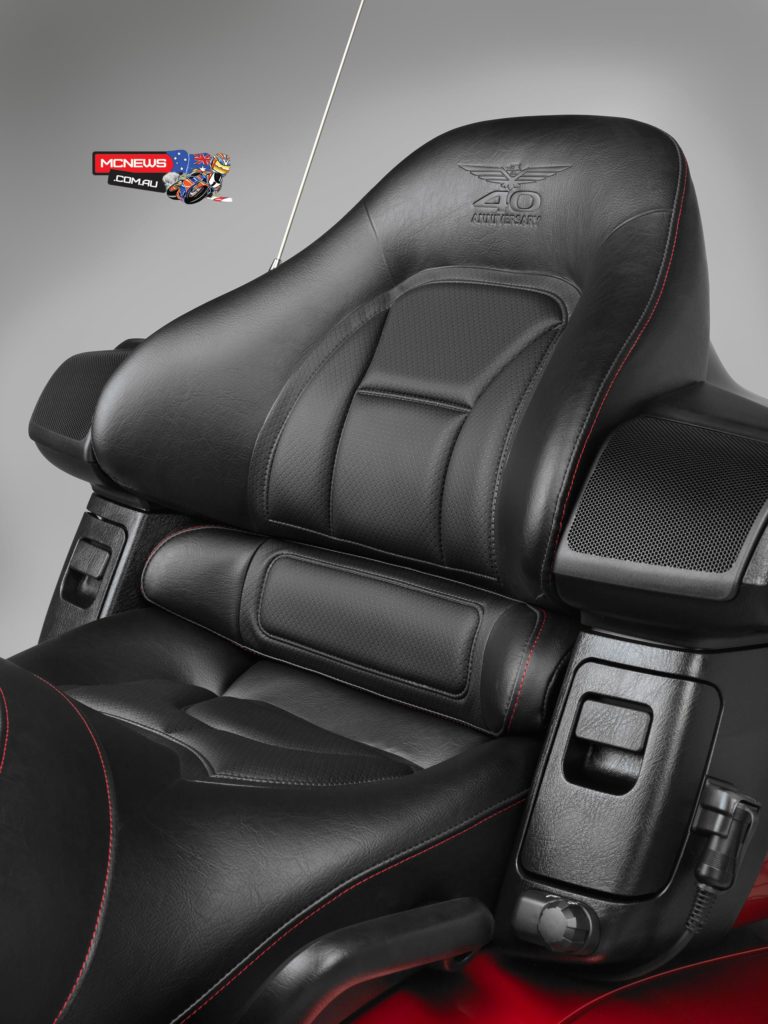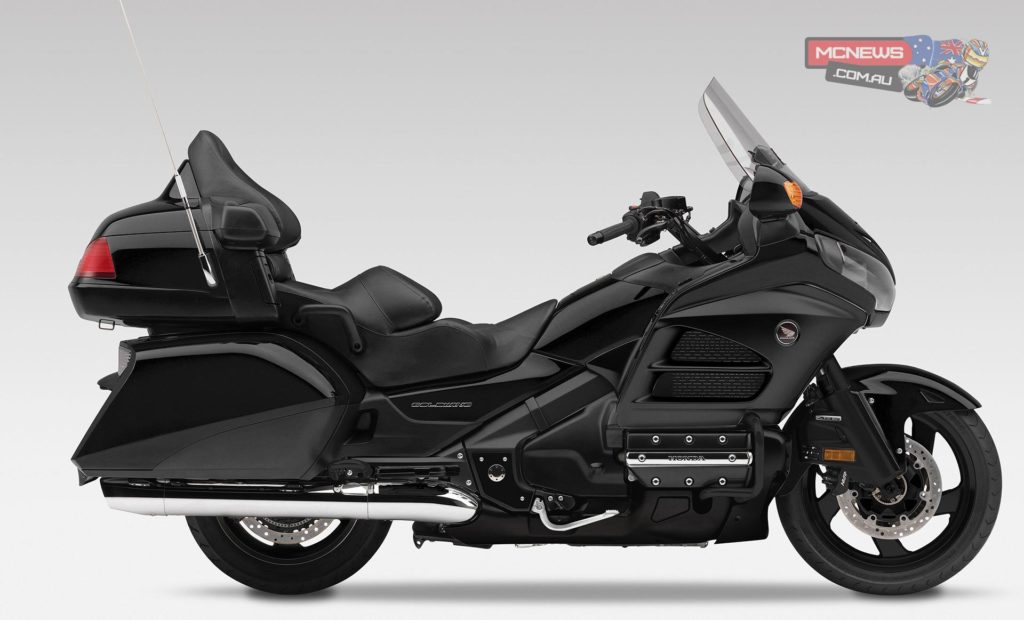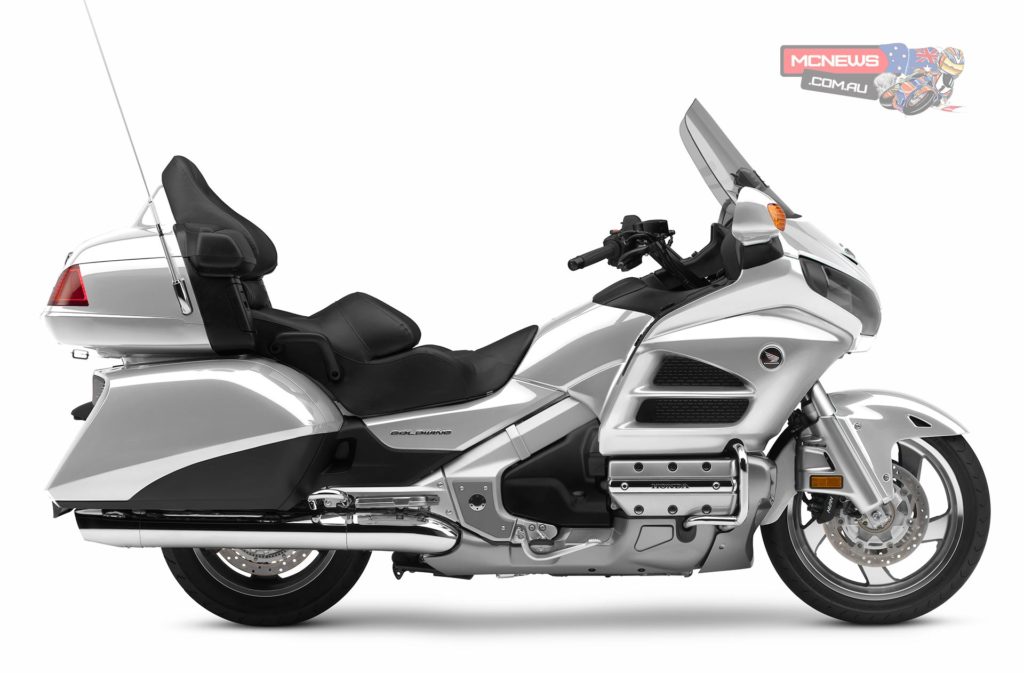2015 GL1800 Gold Wing – Honda Gold Wing 40th Anniversary Model

Machines come and go in the motorcycling world. Times change, as do riders and their expectations. But since 1975 there’s been a bike in the Honda range that has stood the test of time – the Honda Gold Wing. It’s evolved, of course, but just as it was originally, it remains one of the most special experiences available on two wheels.
Many riders are addicted to its avalanche of turbine-like torque, or its handling poise at low – or high – speed. Some revel in its mileage-munching ability, carrying capacity and all-day two-up comfort.
Honda Gold Wing has spawned two other very special machines, broadening its attraction and appeal: the Gold Wing F6B, with its long, low and pared down ‘Bagger’ style and hot rod Gold Wing F6C Valkyrie ‘Power Cruiser’.
To mark 40 years of constant Gold Wing manufacture Honda has produced a 40th Anniversary machine which is expected to arrive in Australia in January, 2015.
Launched as the Honda GL1000 in 1975 its horizontally opposed four-cylinder engine was not only physically different, it felt very different with a silky output perfect for long days in the saddle. A six-cylinder, 1500cc overhaul in 1987 saw the Gold Wing once again state its intent and purpose to benchmark the ultimate touring machine.
The Honda Gold Wing GL1800 which debuted in 2001, after eight years of intensive research and development, added further dynamic ability and riding enjoyment to the Gold Wing’s repertoire. The box-section aluminium frame delivered stability and accurate steering at speed. It also worked with the unique flat-six engine to keep the centre of gravity low – a key factor in the bike’s excellent low-speed balance and agility, which made twisting mountain roads or busy city streets a pleasure to negotiate.
And just as the engine enjoys a legendary reputation for reliability, so the rest of the machine is finished to the very highest standards, with outstanding build quality and paint finish.
The core appeal of the Honda Gold Wing remains its unique ability to make long-distance travel a truly rewarding and enjoyable experience. A visual update in 2011 – with improved luggage capacity – under the style concept of ‘majestic aggression’ perfected a look that is at once elegant, imposing and vibrant.
To celebrate 40 years of production the 2015 Honda Gold Wing will be available in an additional – and very special – two-tone colour scheme, with commemorative key fobs and fairing/trunk badges. The 40th Anniversary badges and key fobs will also be found on the three other Gold Wing colours.
Total luggage capacity is 150 litres and the shape of the rear of the machine actively contributes to aerodynamic stability.
The seat is one of the most important features of a touring motorcycle and the Gold Wing’s has always excelled when it comes to day-long comfort. The shape of the seat wraps around the passenger, creating the sensation of complete comfort and security. A urethane seat material increases comfort, while the weather proof cover is perforated for a sporty look. Seat height of 740mm gives accessible ground reach.

The 2015 Gold Wing 40th Anniversary model will be available in a very special Candy Prominence Red/Graphite Black paint option. Both colours are tied together, and separated, by a silver band inlaid with 40th Anniversary emblems and the effect – along with the blacked out wheels, frame forks, swingarm and mufflers – is simply stunning. Finishing details are the 40th Anniversary emblems on the fairing front and inner, trunk lid and key fob.
Three other colour options, also wearing 40th Anniversary emblems (and complete with special key fob), will also be available:



SRS CS Auto 6-speaker 80W surround-sound system
Offering superb sound presence and quality, this system delivers high quality stereo via a powerful 80-watts-per-channel amplifier capable of delivering clear, crisp sound, even at motorway speeds. The amp powers a full complement of six speakers, with two rear speakers, two front speakers and two tweeters.
The result is a rich and full surround sound experience through either the speaker system or the optional headsets.
The audio system is compatible with iPod®, iPhone® and USB memory sticks, meaning riders can play MP3, WMA and AAC music files on the go. The system is fully integrated, giving full device control through the handlebars and displaying music file information on the main display.
Controls on the central panel take care of switching between music sources (for example radio or USB), switching displays and selecting music while at a standstill. The USB port for connecting digital music devices is in the large lockable top box, which also features an interior storage case to hold the device on the move.
Honda Navigation System (airbag models only)
The Gold Wing’s Navigation System offers fast and accurate functionality. The bright colour screen boasts a range of functions including lane assist and junction view, while optional voice-prompting further reduces the chance of taking a wrong turn. The system also offers points of interest information, including petrol stations, Honda dealers, hotels and restaurants.
Easy to use controls ensure all of these features can be accessed easily and safely. Reception sensitivity allows the system to operate effectively even in areas with a poor signal, such as on roads beneath large structures or on mountain roads.
Central storage compartment (on models without airbag)
On models not fitted with an airbag the handily placed front pocket has 2.8 litres storage space. It is ideal for storing sunglasses, wallets and mobile phones while on the move.
Heated seats and handlebars; foot-warming system
Five-position heated grips and independently adjustable heated seats make touring a year-round possibility. The foot-warming system channels engine-heated air over the rider’s feet and is controlled by a fairing-mounted lever.
Reverse Gear
The slow-speed, electric Reverse system is engaged with the simple push of the thumb control on the right handlebar.
Cruise Control
Lightweight electronic cruise-control system utilises a 16-bit ECU-based, motor-actuated throttle mechanism.
Adjustable windscreen
A simple yet ingenious ratchet windscreen-adjustment system provides six settings over nearly 100mm of travel. The manually operated adjustable and closeable windscreen vent routes fresh air to the rider’s face or chest.
Luggage capacity
Between the fairing pockets, top box and rear panniers, the Gold Wing boasts over 150 litres of luggage capacity. The specially designed luggage features a remote-control key lock, permitting pop-open rear trunk operation, remote lock/unlock for the trunk and panniers and a horn-actuated bike locator. If remote locking is attempted while a lid is open, the turn signals flash to alert the rider.
The horizontally opposed SOHC 2-valve six-cylinder engine is as much a part of the Gold Wing legend as the name or the sales success. Unique in motorcycling, the 1832cm³ engine is the perfect long-distance ally.
Flat-Six Engine
Its layout minimises engine vibration and helps create a low centre of gravity, reducing rider fatigue at speed and making the bike easy to handle at walking pace. At the same time the large displacement gives exceptional power and torque, especially in the midrange. Bore and stroke is set at 74mm x 71mm, with compression ratio of 9.8:1. Peak torque of 167Nm is delivered at just 4,000rpm, with power output of 87kW @ 5,500rpm.
PGM-FI fuel injection ensures a crisp throttle response and low exhaust gas emissions. Together, the fuel injection system’s fine air/fuel ratio control, the three-way catalytic converter and the air injection system – that encourages the oxidisation of unburned gases – ensure that the Gold Wing easily meets EURO-3 emissions standards. For longer maintenance intervals, automatic adjustment for the silent cam chain has been retained.
The engine’s power is transmitted to the rear wheel through a five-speed gearbox spinning the opposite way to the engine’s crankshaft. This cancels out the side-to-side torque reaction effect generated by longitudinally mounted engines. Fifth gear is an overdrive, offering very low cruising revs on a long haul for optimised comfort and reduced fuel consumption. Shaft final drive means no messy chain lubrication or adjustment.
Chassis
The skeleton of the Gold Wing is a twin-spar aluminium beam frame which holds the engine as a stressed member, improving its already outstanding levels of rigidity, while the design’s low weight and optimised weight distribution make it a joy to ride at any speed. Rake is set at 29.15°, trail 109mm. Overall dimensions are (L) 2,630mm × (W) 945mm × (H) 1,455mm with wheelbase of 1,690mm and kerb weight of 413kg (421kg airbag model).
Both the 45mm cartridge front telescopic forks and Pro-Link single-side swingarm rear suspensionuse low-friction bushes, with the forks also benefitting from low-friction dust seals. Equipped with a two-position memory function, the computer-controlled, electric hydraulic-type adjustable rear suspension allows for quick adjustments to spring preload depending on load.
The Gold Wing is fitted with Honda’s Dual Combined ABS. The Combined element of the system links the front and rear brakes to deliver the perfect balance of braking effort, whether the rider uses the front brake lever or the rear foot brake for high levels of deceleration in all situations. The ABS monitors front and rear brakes – a pair of 296mm discs and three-piston calipers at the front, and a ventilated 316mm disc and three-piston caliper at the rear. Braking effort is momentarily reduced should the system detect that a wheel is about to lock up. Hollow section 5-spoke cast aluminium wheels are sized (front) 18 x MT3.5 and (rear) 16 x MT5. They wear 130/70 R18 (63H) and 180/60 R16 (74) tyres respectively.
In addition to the standard model, the Gold Wing is also available fitted with a fully integrated airbag, which represented an industry-first when introduced in 2006. The airbag module containing the airbag and inflator is positioned in front of the rider. The ECU to the right of the module detects changes in acceleration based on information it receives from the two crash sensors (one positioned on each of the front fork legs), to determine whether or not to inflate the airbag in certain frontal impacts.
Note: all models fitted with airbag are also installed with satellite navigation.

Specifications – GL1800 Gold Wing (ED-type without airbag)
- Engine – Liquid-cooled 4-stroke 12-valve SOHC flat-6
- Displacement – 1,832cc
- Valves per cylinder – 2
- Bore x Stroke – 74 x 71 mm
- Compression Ratio – 9.8: 1
- Max. Power Output – 87kW/5,500rpm (95/1/EC)
- Max. Torque – 167Nm/4,000rpm (95/1/EC)
- Oil Capacity – 4.6L
- Carburation – PGM-FI electronic fuel injection with automatic choke, 40mm throttle body
- Fuel Tank Capacity – 25 litres (including 4.4L warning light reserve)
- Fuel Consumption – 15.24km/l (WMTC mode)
- Clutch Type – Hydraulic, wet, multiplate with coil springs
- Transmission Type – 5 speed (including overdrive. Plus electric reverse)
- Final Drive – Enclosed shaft
- Frame – Diamond; triple box section aluminium twin spar
- Dimensions (L´W´H) – 2,630mm x 945mm x 1,455mm
- Wheelbase – 1,690mm
- Caster Angle – 29° 15′
- Trail — 109mm
- Turning radius – 3.3m
- Seat Height – 740mm
- Ground Clearance – 125mm
- Kerb Weight – 413kg (F: 185kg; R: 228kg) – * 421kg airbag version (F: 189kg; R: 232kg)
- Maximum loaded weight – 603kg / * 611kg airbag version
- Front Suspension – 45mm telescopic fork with anti-dive, 140mm stroke
- Rear Suspension – Pro-Link Pro-Arm with electronically-controlled spring preload adjustment, 105mm axle travel
- Tyres – 130/70 R18 (63H) Front – 180/60 R16 (74H) Rear
- Braking – Dual Combined ABS – 296 x 4.5mm dual hydraulic disc with 3-piston calliper, floating rotors and sintered metal pads (F) – 316 x 11mm ventilated disc with 3-piston calliper and sintered metal pads (R)
Gold Wing – Evolution of a touring benchmark
1972: the beginning
A new design team is assembled under Soichiro Irimajiri, who headed up the design of Honda’s five-cylinder and six-cylinder road racing engines in the 1960s. Their brief is to explore the outer limits of the Grand Touring concept. How refined and luxurious can a motorcycle be when it is designed from the outset as a machine for covering big distances? The team creates the top-secret M1 prototype. Powered by a liquid-cooled, horizontally opposed six-cylinder engine with shaft final drive – features that will subsequently find their way onto the production Gold Wing as it evolves – the M1 blends superb performance with unrivalled refinement.
1975: GL1000 Gold Wing
The first production Gold Wing is a revolution, opening up new possibilities for long-distance motorcycle travel. With world-class power from its unique 999cm3 liquid-cooled horizontally opposed four-cylinder engine, the GL1000 Gold Wing combines peerless cross-country speed with a level of refinement never before experienced on two wheels. Gold Wing customers redefine touring, riding further and faster than had been possible before, confident in a machine that from the very beginning enjoyed a legendary reputation for complete reliability. In 1976 Honda celebrates the Gold Wing’s success with the stunning Gold Wing Limited Edition model, and in 1979 the first Honda of America manufacturing plant opens, reflecting the fact that 80 percent of Gold Wing production is being exported to the United States.
1980: GL1100 Gold Wing & GL1100 Gold Wing Interstate
Where the GL1000 defied categorisation with its blend of superbike power and touring comfort, the GL1100 – released after five years of intensive consumer-led development – firmly establishes the Gold Wing as a Grand Tourer par excellence. The larger 1085cm3 engine is developed for torque rather than power, while a longer wheelbase offers increased stability and more room for the rider and passenger. The air-assisted suspension sets new standards for motorcycle ride quality. At the same time the GL1100 Interstate introduces the idea of turn-key touring, with its factory-fitted fairing, panniers and top box.
1982: GL1100 Gold Wing Aspencade
The most luxurious Gold Wing to date offers an unparalleled range of standard features, from LCD instrumentation and a CB radio to an onboard air compressor
1985: GL1200 Limited Edition
The Gold Wing’s market position is underlined by the discontinuation of the standard, unfaired GL1200 and the introduction of the GL1200 Limited Edition, complete with computerised fuel injection, a four-speaker sound system, cruise control, auto-levelling rear suspension, a travel computer and metallic gold paint.
1988: GL1500 Gold Wing
The brief is exacting in the extreme: the new Gold Wing has to be quieter, smoother, faster, more comfortable and even better in the corners. The GL1500 development team evaluates 15 different machines in 60 prototype stages. The result is a six-cylinder luxury tourer so accomplished that it establishes a benchmark that goes on to dominate motorcycling for more than a decade.
2001: GL1800 Gold Wing
A full eight years in development, the GL1800 model takes the Gold Wing to previously unimaginable heights. Steered by Masanori Aoki, whose CV includes the CBR250RR, the CBR400RR and the much-lauded CBR600F3, the Gold Wing becomes a dynamic sensation. In Aoki-san’s words: “My job is to add more fun factor, to build a Gold Wing with the kind of acceleration and handling people normally associate with sporting machines.” Alternative engines are tested but ultimately rejected and in 2001 the GL1800 is launched. The bike’s horizontally opposed six-cylinder engine is mounted in a box-section aluminium frame for superb road holding, handling and stability. In the course of the bike’s development no less than 20 technological innovations are patented.
2006: Industry-first airbag
The 2006 model introduced initially in the USA featured and the world’s first airbag on a production motorcycle, as well as revised taillights and instrument panel.
2011: New styling
The Gold Wing receives a new look under the styling concept of “majestic aggression”. The vitality and excitement of the bike’s handling and performance are reflected in looks that are at once elegant, imposing and dynamic. Luggage capacity is increased to 150 litres and a new six speaker audio system offers multiple connectivity options.
2013: Gold Wing F6B
The custom-styled Valkyrie (1996-2003) and unique, limited edition Rune (2003) – both sold in the USA – had used the Gold Wing engine. In 2013, the Gold Wing family gains a true second member with the stripped out, long and low Gold Wing F6B: a unique custom-touring motorcycle with Bagger styling, big on excitement and flair.
2014: Gold Wing F6C
A third machine takes the Gold Wing name. Low, mean and muscular, the Gold Wing F6C injected a jolt of adrenaline into the power cruiser arena.























